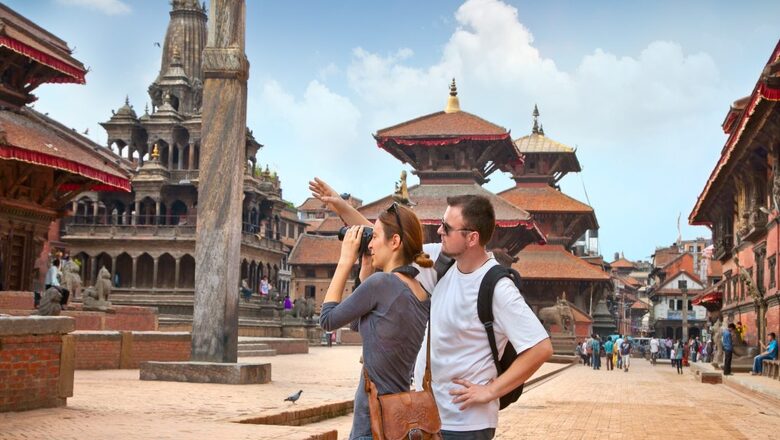
views
Today, Wednesday, September 27, 2023, is World Tourism Day. Since 1980, the United Nations World Tourism Organisation (UNWTO) has celebrated World Tourism Day as an international observance on September 27. This date was chosen as on that day, in 1970, the Statutes of the UNWTO were adopted. The theme for the celebration this year is ‘Tourism and Green Investments’. The rotating host country for World Tourism Day 2023 is Saudi Arabia where the official celebration is being held today.
Tourism Matters for India
According to the latest data released from the World Travel & Tourism Council (WTTC), the contribution of the travel and tourism sector to the Indian economy in 2022 was $190 billion (Rs 15.7 trillion), just 3.5 per cent below 2019. It will reach $201.37 billion (Rs 16.5 trillion) by 2023 end.
Unsurprisingly in 2022, the travel and tourism sector in India employed 37.2 million people, which is likely to go up to 39 million people by the end of the year, with the addition of more than 1.6 million new jobs during the year. Instructively, the sector will account for one in thirteen workers in India overall.
The Number Theory: The Game Just Got Bigger
If one goes by the WTTC projections, in the next decade, the contribution of travel and tourism to the Indian economy will grow to a staggering $451.56 billion (Rs 37 trillion). As per a more proximate assessment in 2023 by the Travel Agents Association of India (TAAI,) the contribution of tourism to the Indian GDP will be a humungous $512 billion in 2028 and accounting for 53 million jobs by 2029.
The Dichotomy
Tourism in India is riddled with dichotomy. As per the Government of India’s official statistics of India Tourism 2022, the country accounted for 677.63 million domestic tourist visits in 2021, an increase of 11.05 per cent from 610.22 million in 2020. Contrarily, with the subdued impact of the pandemic, foreign tourists in India in 2021 were merely 1.05 million. Even the pre-covid numbers at 7.17 million left much to be desired.
Worse, as per WTTC numbers, even in 2022 spending of overseas tourists was a mere $19.53 billion (Rs 1.6 trillion) with the domestic tourist outstripping it with a $150.11 billion (Rs 12.3 trillion) contribution. Further, it is estimated that in 2023, while the international tourism contribution to Indian GDP will go up to $24.41 billion (Rs 2 trillion), the real driver will continue to be domestic tourism spending at $153.78 billion (Rs 12.6 trillion), a number that will gallop to $350.26 billion (Rs 28.7 trillion) over the next one decade. As regards international tourist spending in India, even after the next decade, it will crawl to $50.04 billion (Rs 4.1 trillion).
Tip of the Iceberg
I begin with a comparison of the tiny Thailand and the big India, soon to be the most populous country in the world. Thailand, the only Asian country in the global top ten in terms of international tourist visitors’ nations, is also known as the ‘Land of Smiles’, which offers both modern comforts and wild adventure. Thailand’s capital, Bangkok, receives over 20 million visitors every year. Popular attractions include the Grand Palace in Bangkok; beaches including Railay, Long, and Monkey Beach; the ancient city Ayutthaya and ornate Buddhist wat Coi Suthep, and national parks including Khao Yai (where wild elephants roam) and the otherworldly Khao Sok.
Before Covid-19 massacred world tourism, in 2019, the number of international tourist arrivals in Thailand was 39.8 million with a defining 11.85 per cent contribution to its GDP. And that number was not an aberration. In five years, from 2015 to 2019, the percentage of contribution of international tourism to Thailand’s economy was 11.18 per cent (2015), 11.72 per cent (2016), 12.5 per cent (2017), 12.11 per cent (2018) and 11.83 per cent (2010). International tourist arrivals in Thailand inched back to 11.15 million in 2022 and surged to 6.5 million in the first quarter of 2023. In 2024, it is likely to cross 40 million.
In comparison, the best pre-Covid number was 10.93 million Foreign Tourist Arrivals (FTAs) in India in 2019 spending more than $30 billion. This number dwindled to 2.74 million in 2020, 1.52 million in 2021 and increased somewhat to 6.19 million in 2022.
In this context, international tourists, in general, spend 26 times more than domestic tourists during their visit. And the financial benefit of international tourism is significant. Mere in terms of foreign exchange earnings from tourism in India saw a remarkable increase of 107 per cent, reaching Rs 1,34,543 in 2022. This substantial growth in earnings emphasises why India must be made a favoured destination to global visitors including high net worth Indian diaspora.
Whither Incredible India
A question that comes to my mind is, is there any explanation at all for the Atithi Devo India (the incredible India) to perform so miserably compared to the tiny Thailand? And even if the comparison is out of place, what the country needs to evolve, expand, restructure, reimagine and reinvent its tourism business, particularly the languishing international tourism, the big fat forex earner and with huge employment generation potential.
Tourism – A Constitutional Orphan in India
On August 02, 2001, replying to a question in the Lok Sabha, the then Minister of Tourism & Culture Ananth Kumar in the NDA government of Atal Bihari Vajpayee said that tourism as a subject was neither in the Union list nor in the list of the Seventh Schedule of the Constitution, he was telling the obvious.
Ironically, when the framers drafted the Constitution of India, the word ‘tourism’ was farthest from their minds. All they could do in its place was insert ‘Pilgrimage to places outside India’ (item no 20 Union List) and Pilgrimages other than those outside India (item no 7 in List 2, State List).
Tourism was born an orphan in the Constitution of India in 1950, it continued to be an orphan in 2001 when the NDA government first enlisted the views of state governments to put it on the Concurrent List and remains an orphan in the ‘Amrit Kaal’ after 76 years of independence. It is no brainer despite having such immense potential as one of the biggest contributors to GDP, with a strong employment multiplier effect, as late as FY24, annual union budget tourism continues to get the step-motherly treatment with a pittance of out of Rs 2400 crores allocated to Ministry of Tourism.
India’s Rank in Global Travel and Tourism Development Index
In the latest Global Travel and Tourism Development Index (2021) published by the World Economic Forum in 2022, India slipped down to 54th place out of 117 countries (from 46th place in the 2019 rankings) when compared to an index consisting of five sub-indexes, 17 pillars and 112 individual indicators. Unsurprisingly, Japan tops the global index, followed by the US, Spain, France, Germany, Switzerland, Australia, the UK, Singapore and Italy in the top ten.
Reason Why India Languishes
India is a vast country, one of the oldest civilizations of the world, is geographically diverse and offers a variety of cultures that come with its own experiences, making it one of the leading countries in terms of international tourism expenditure. Its big coastline is dotted with majestic beaches while different parts of the nation have diverse attractions of hill tourism. India is home to one of the finest monuments in the world and travel and tourism are two of the largest industries in the country, with a total contribution of about $178 billion to the country’s GDP, despite vast untapped potential. If that is not enough, in terms of world rankings by the World Travel & Tourism Council (WTTC), India is ranked as the 2nd country in terms of Travel & Tourism Employment in 2021and was ranked 6th in 2021 in terms of Contribution of Travel & Tourism to GDP.
Still, India languishes as the positioning in the index shows and that is a big dampener. The big question is why? The short answer is tourism is a constitutional orphanage. The lowly position on the index exemplifies a lower position of the country on five subindices – Enabling Environment, Travel and Tourism Policy and Enabling Conditions, Infrastructure, Travel and Tourism Demand Drivers and Travel and Tourism Sustainability. Comparing the individual sub-indexes of TTDI, India lost considerably on the Enabling Environment and Policy and Enabling Conditions sub-index, where the country’s ranking fell by 17 and 7 points respectively in comparison to the 2019 rankings.
If we dive further into the 17 pillars, India lost most points and ranks on Business Environment, where its position dropped to a lowly low of 92 in 2021 and the Human Resource and Labor Market, where it has slipped to 98th position.
And the list goes on.
Multiple Tourism Growth Drivers
Indian tourism sector has incredible growth drivers in heritage tourism, cultural tourism, medical tourism, business tourism and MICE, sports tourism and coastal tourism.
- About 60 per cent of domestic tourism in India remains spiritual in nature and 30.5 million international travellers are expected to visit India by 2028 for spiritual tourism.
- Medical and wellness tourism – India with its high quality and lower cost is a natural magnet for medical and wellness tourism. In 2021, 21 per cent of internationals were on this account for medical treatment in India. The medical tourism segment has the potential to create nearly 24 million jobs by 2032.
- Adventure and sports tourism – Comparative number indicates that an average adventure and sports tourist spends about $2,900 per trip, which has the potential to create 6 million jobs by 2032. This is one area which has a crying need for better infrastructure.
- Business and MICE tourism: India soon will be the world’s third-largest economy. Also, India is one of the biggest consumer markets of the world with the size of India’s middle class being larger than the US population. India is today the centre of attraction for global businesses and the nation, apart from being the leader in many services industries, is fast becoming a world alternative manufacturing hub. This being the case, business travel and MICE (Meetings, Incentives, Conferences, and Exhibitions) hold huge future potential. In 2021, 12.1 per cent of foreign tourists visited India for business purposes. India’s share in the global MICE market is expected to increase in the coming years.
- With an investment worth $1.5 trillion (through the National Infrastructure Pipeline Scheme 2020-25), the number of airports in India will increase to 220 by 2025. India is the fastest-growing aviation market in the Asia Pacific. There is tremendous growth opportunity here.
India’s Road to Nowhere in Global Tourism
According to the World Tourism Organisation’s publication ‘World Tourism Barometer’, a total of 917 million international tourists travelled the world in 2022. Aspiring adventurers and globetrotters have proven themselves to be resilient and resourceful. The subsequent pent-up demand, coupled with an easing of travel restrictions, led to a 102 per cent increase in international tourism compared to 2021. Though not yet there, global travel and tourism is fast inching towards reaching and moving beyond the $8.9 trillion business it was in 2019.
In terms of tourism, the ten leading nations in terms of arrivals are France – 90.0 million, Spain – 83.7 million, the United States – 79.3 million, China – 65.7 million, Italy – 64.5 million, Turkey – 51.2 million, Mexico – 45.0 million, Thailand – 39.8 million, Germany – 39.6 million, and United Kingdom – 39.4 million.
When it comes to destination world tourism, India is still on the road to nowhere. Its best pre-pandemic provision was 10.93 million Foreign Tourist Arrivals (FTAs) in India in 2019. This number dwindled to 2.74 million in 2020, 1.52 million in 2021 and increased somewhat to 6.19 million in 2022.
Way Forward- Reimagining the Future of Indian Tourism
In 2022, the National Conference of State Tourism Ministers adopted the “Dharamshala Declaration” which affirms commitment toward developing “sustainable and responsible tourism” and positioning India as a “global leader in the tourism sector by 2047”. This lofty ambition is in danger of dying in infancy unless it is backed by concrete vision, statute, policy and program rebooting. As a starter, India has to take the following immediate steps to reimagine and reinvent Indian tourism.
One, 76 years is too long a period for tourism to survive as a constitutional orphan. It is at once needed that in the coming Winter Session of the Parliament, the Constitution of India is amended to bring tourism into List 3, the Concurrent List of Schedule 3 of the Seventh Schedule. I am no expert on the Constitution, but I believe that something which does not exist in the Seventh Schedule at all is in the residual power of the Government of India, and it should pose no hurdle in bringing it to List 3, though given its importance to the national economy, its rightful place belongs to List 1- Union List.
Two, enabling statute, bringing tourism into the Concurrent List is the beginning. India, one of the few oldest civilisations in the world, has no business to languish in the bottom half as a preferred destination. The country is in crying need of a visionary national statute that takes the development of tourism in the mission mode. India will not become a leader in the tourism industry in 2047 by default, the country needs best practices statute and national policy and its robust implementation.
Three, the government’s only approach was a disaster. The first public milestone in the history of tourism was the creation of the Indian Tourism Development Corporation (ITDC) in 1966, meant to develop tourist infrastructure and services. On a state level, similar Corporations were established, though very reluctantly and after considerable delay. Their budgets were small, and the scales of their operations were limited. Moreover, the tourist services they offered were generally considered substandard and indifferent. Over time, they became obsolete. But the nation failed to learn its lessons.
Four, tourism cannot prosper in the vacuum of a robust national policy. With the prospect of hosting the Asian Games of 1982, the Indian government first thought of having a National Tourism Policy, 1982, which provided an action plan based on the development of the so-called tourism circuit. The policy was structurally deficient and failed at implementation. The second National Tourism Policy, 2002, aiming largely at domestic tourism was in many respects old wine in a new bottle. And it’s turned into a road to nowhere. The latest policy Draft National Tourism Policy, 2022 has been in the making for three years and even a cursory reading of the draft policy does not inspire confidence. India has a long way to go, and time is running out.
Five, one size does not fit all. Merely national policy will not take the nation anywhere. Every state needs global best practices, and the State Tourism Policy, and there exists an immediate need to rank states on their tourism competitiveness index. Some states like Kerala, the God’s Own Land, have performed much better than front-ranking states.
Six, as the Parliamentary Standing Committee on Transport, Tourism and Culture has already suggested, there is an immediacy to fast-track the creation of a ‘National Tourism Council’ on the lines of the GST council to directly make recommendations to the Central and state governments on various issues of the tourism sector and its stakeholders.
Seven, the industry status to tourism and hospitality needs to be given at the national level. As of now, merely eight states—Maharashtra, Gujarat, Madhya Pradesh, Kerala, Karnataka, Punjab, Rajasthan and Uttarakhand—have accorded industry status to hospitality projects and 20 states are yet to wake up.
To verbatim quote the Parliamentary Standing Committee on Tourism, “Vision without action is a daydream and action without a vision is a nightmare”.
As a keen watcher of India’s tourism sector, the author is perplexed that despite the potential to reach there, without reimagining and purposive reinventing, how will India’s Non-Performing Asset (NPA) tourism get converted into a $1 trillion business by 2047. And how India will reach there without a long-term action plan to pump prime both international and domestic tourism.
The author is a Multi-Disciplinary Thought Leader and India-based International Impact Consultant. He works as President Advisory Services of Consulting Company, BARSYL. Views expressed in the above piece are personal and solely that of the author. They do not necessarily reflect News18’s views.


















Comments
0 comment